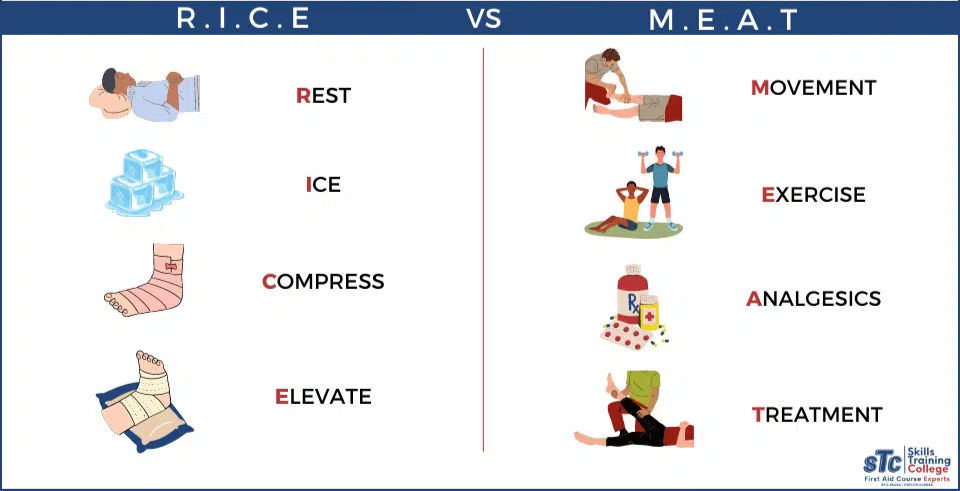The Right way to Heal an Ankle Sprain
- John Lu
- Jul 5
- 3 min read
Updated: Jul 7

An ankle sprain is one of the most common injuries people experience especially in sports that involve quick changes and jumping. Traditionally, people have relied on the RICE method an acronym that stands for Rest, Ice, Compression, and Elevation. This approach was founded by Dr. Gabe Mirkin in his 1978 book Sportsmedicine, which covered many kinds of injury management plans. However, recent research has shown that RICE may not be the most effective method for recovery. In fact, some aspects of the RICE protocol may even delay the natural inflammatory that's crucial for recovery. In this discussion, I’ll introduce two more modern and science supported approaches to ankle sprain rehab, explaining how they work and why they offer better outcomes than the RICE method.
RICE
When RICE was first introduced it was considered effective for its primary goal which was reducing pain and swelling. While it does provide temporary relief, recovery is more complex than feeling less pain. Healing involves the growth and strengthening of the soft tissues and ligaments that were damaged. Pain management is just one part of the process regaining function, mobility, and long-term resilience is equally important. Moreover, recent research shows that a certain level of inflammation is actually beneficial to the healing. Inflammation is the body’s natural response to injury it brings immune cells and nutrients to the damaged area. RICE can potentially slow down this process and recovery weaker and slower.
Pros | Cons |
|
|
|
|
|
|
MEAT
MEAT is an acronym that stands for Movement, Exercise, Analgesics, and Treatment compared to RICE which focuses on reducing pain and inflammation, MEAT prioritizes the healing and rebuilding of tissues. The idea is that controlled movement and exercise promote blood flow, improve tissue growth, and lead to a stronger and more resilient ankle. However, while MEAT comes with many advantages, it also comes with potential risks. Introducing movement too early or without proper guidance can cause overexertion, which can worsen the injury or delay the process. That said, when applied appropriately, the increased circulation from movement causes faster recovery and improved tissue strength compared to the RICE approach. The addition of analgesics and treatment in MEAT further supports recovery, over the counter pain killers can help manage pain and reduce some unnecessary swelling without completely stalling the natural healing process. MEAT represents a more modern approach to injury recovery, reflecting the current understanding of how tissues heal. Still, it has its limitations; It must be tailored to the persons condition and setbacks to ensure the best outcomes.
Pros | Cons |
|
|
|
|
|
|

Peace and Love

The PEACE and LOVE acronym represents a modern approach to immediate and ongoing injury management moving beyond the traditional RICE and MEAT method. It emphasizes two distinct phases: PEACE for the immediate post-injury period and LOVE for the second phase when swelling has reduced and mobility is improving. PEACE stands for (Protection) when you shield and prevent further damage to the ankle for 1-3 days, (Elevation) Having your ankle above the heart to reduce swelling, (Avoid) Anti-inflammatories making sure to not use any drugs or artificial icing as these can even hider the healing, (Compression) tying the ankle tight to reduce swelling and discomfort, and (Education) informing the injured person the importance of following a guideline with deliberate healing. LOVE guides the longer-term rehab: (Load) slow but progressive increase of load on the ankle to rebuild strength and stability, (Optimism) having a positive mindset while recovering can in fact boost the healing process, (Vascularization) using cardiovascular activities to promote oxygen deliver to the damaged ankle and nutrient transfer for strength rebuilding, and (Exercise) adding exercises tailored to the injured person to have them regain function in the ankle and slowly rebuild the ankle. This new approach is the best balance between pain relief and recovery as it uses vital parts from both RICE and MEAT to achieve the best recovery plan.
Works Cited
Course Experts , First aid . “What Is the Difference R.I.C.E vs. M.E.A.T Sprain First Aid.” First Aid Course Experts, 3 May 2022, firstaidcourseexperts.com.au/sprain-treatment/.
Orthopedic , Cove. “Ankle Sprain Treatment Singapore - Cove Orthopaedic Clinic.” Cove Orthopaedic Clinic, www.coveorthopaedics.com.sg/conditions-we-treat/foot-ankle/ankle-sprain/.
Virginia , Orthopedic Center. “Ankle.” Orthopaedic Center of the Virginias, ocvweb.com/ankle/.

Comments